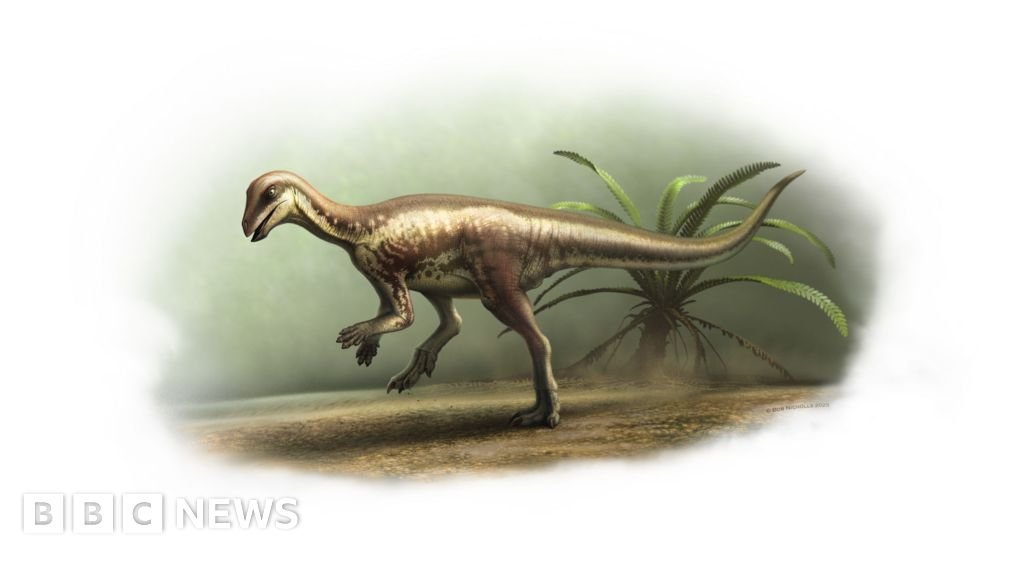Newly Identified Dinosaur Species and Its Unique Significance at the Natural History Museum, London (2025)
By Georgina Rannard, Science Correspondent
Reporting from the Natural History Museum, London
The scientific community has marvelously redefined a labrador-sized dinosaur that was previously misclassified, revealing it as a distinct new species named Enigmacursor mollyborthwickae—derived from the Latin for "puzzling runner." This small dinosaur roamed approximately 150 million years ago during the Late Jurassic period, sharing its habitat with iconic giants like the Stegosaurus.
Initially thought to belong to the Nanosaurus family, researchers at the Natural History Museum (NHM) have concluded that this categorization was incorrect. This Thursday marks a notable moment, as Enigmacursor will be the first new dinosaur species displayed at the NHM since 2014.
Behind the scenes, BBC News had exclusive access to the preparations for this significant reveal. According to Professor Paul Barrett, a palaeontologist at the museum, this discovery sheds light on the evolutionary trajectory that transitioned early small dinosaurs into the larger, more extraordinary species that would follow.
During our visit, the designer of the specialized glass display case was performing final adjustments. Enigmacursor will be prominently featured in a dedicated exhibit in the Earth Hall, just above another fossil relic, Steph the Stegosaurus, who also hailed from the Morrison Formation of the Western United States.
At just 64 cm tall and 180 cm long, Enigmacursor appears diminutive next to its colossal contemporaries, yet it boasts distinct features—larger feet and a disproportionately long tail. Professor Susanna Maidment notes that its small head suggests limited intelligence, implying it might have been a teenager at the time of its death.
In a lab setting, conservators Lu Allington-Jones and Kieran Miles were meticulously assembling the dinosaur’s skeleton onto a sturdy metal frame. "We’re taking utmost care during assembly; we want to avoid any damage before the public unveiling," shared Ms. Allington-Jones, the head of conservation.
Insights Into Its Characteristics and Evolutionary Context
With its solid, dense hips, Enigmacursor was likely a swift runner, although its smaller front arms may have been better suited for foraging foliage. The discovery of its bones led NHM scientists to declare it a new species. "Identifying new species hinges on the minutiae of anatomical differences," explained Professor Maidment while showcasing the dinosaur’s right hind limb.
When the specimen arrived at the museum, it was labeled as Nanosaurus—a classification common among various small dinosaurs since the late 19th century. However, suspicions about its true identity prompted an investigation that traveled as far as the United States to examine the original Nanosaurus, which turned out to lack any substantial bones—only impressions in rock.
In contrast, the NHM specimen features a near-complete skeleton, facilitating a better understanding of small dinosaurs. It’s vital for palaeontologists to accurately categorize species, as inaccuracies can distort our comprehension of evolutionary history. Thus, the Nanosaurus classification has been formally eradicated by researchers.
Discovering other small dinosaurs from this era is likely, enhancing our understanding of diversity during the Late Jurassic period. As Professor Barrett aptly noted, "Understanding these early forms is crucial. It allows us to trace the gradual evolution leading to the larger and more bizarre descendants."
The findings on Enigmacursor mollyborthwickae have been published in Royal Society Open Science, reinforcing the importance of carefully examining often-overlooked small fossils. As interest in small dinosaurs grows, researchers urge the community to remain vigilant in uncovering these delicate pieces of history.

